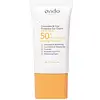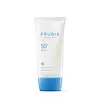What's inside
What's inside
 Key Ingredients
Key Ingredients

 Benefits
Benefits

 Concerns
Concerns

 Ingredients Side-by-side
Ingredients Side-by-side

Water
Skin ConditioningDibutyl Adipate
EmollientGlycerin
HumectantDiethylamino Hydroxybenzoyl Hexyl Benzoate
UV FilterBis-Ethylhexyloxyphenol Methoxyphenyl Triazine
Skin ConditioningButyloctyl Salicylate
Skin ConditioningPolysilicone-15
UV FilterDicaprylyl Ether
EmollientButylene Glycol
HumectantMethylene Bis-Benzotriazolyl Tetramethylbutylphenol
UV FilterNiacinamide
SmoothingEthylhexyl Triazone
UV AbsorberCaprylyl Methicone
Skin ConditioningPhenethyl Benzoate
EmollientDiethylhexyl Butamido Triazone
UV Absorber1,2-Hexanediol
Skin ConditioningPentylene Glycol
Skin ConditioningCetearyl Alcohol
EmollientCentella Asiatica Extract
CleansingCentella Asiatica Flower/Leaf/Stem Extract
Skin ConditioningCentella Asiatica Leaf Extract
Skin ConditioningAsiaticoside
AntioxidantAsiatic Acid
Skin ConditioningMadecassic Acid
Skin ConditioningMadecassoside
AntioxidantCeramide NP
Skin ConditioningGlucose
HumectantFructooligosaccharides
HumectantFructose
HumectantXylitylglucoside
HumectantAnhydroxylitol
HumectantXylitol
HumectantTocopherol
AntioxidantSodium Hyaluronate
HumectantChlorella Vulgaris Extract
Skin ConditioningCandida Bombicola/Glucose/Methyl Rapeseedate Ferment
AntimicrobialHelianthus Annuus Seed Oil
EmollientPropanediol
SolventDipropylene Glycol
HumectantTocopheryl Linoleate/Oleate
AntioxidantCetearyl Olivate
Glyceryl Caprylate
EmollientGlyceryl Stearate Citrate
EmollientIsopropyl Myristate
EmollientIsopropyl Palmitate
EmollientPolyglyceryl-3 Distearate
EmulsifyingSodium Phytate
Sorbitan Olivate
EmulsifyingXanthan Gum
EmulsifyingEthylhexylglycerin
Skin ConditioningTromethamine
BufferingC20-22 Alcohols
Emulsion StabilisingC20-22 Alkyl Phosphate
EmulsifyingHydroxyethyl Acrylate/Sodium Acryloyldimethyl Taurate Copolymer
Emulsion StabilisingMethyl Methacrylate Crosspolymer
Sodium Acrylates Crosspolymer-2
AbsorbentVinyl Dimethicone/Methicone Silsesquioxane Crosspolymer
Decyl Glucoside
CleansingWater, Dibutyl Adipate, Glycerin, Diethylamino Hydroxybenzoyl Hexyl Benzoate, Bis-Ethylhexyloxyphenol Methoxyphenyl Triazine, Butyloctyl Salicylate, Polysilicone-15, Dicaprylyl Ether, Butylene Glycol, Methylene Bis-Benzotriazolyl Tetramethylbutylphenol, Niacinamide, Ethylhexyl Triazone, Caprylyl Methicone, Phenethyl Benzoate, Diethylhexyl Butamido Triazone, 1,2-Hexanediol, Pentylene Glycol, Cetearyl Alcohol, Centella Asiatica Extract, Centella Asiatica Flower/Leaf/Stem Extract, Centella Asiatica Leaf Extract, Asiaticoside, Asiatic Acid, Madecassic Acid, Madecassoside, Ceramide NP, Glucose, Fructooligosaccharides, Fructose, Xylitylglucoside, Anhydroxylitol, Xylitol, Tocopherol, Sodium Hyaluronate, Chlorella Vulgaris Extract, Candida Bombicola/Glucose/Methyl Rapeseedate Ferment, Helianthus Annuus Seed Oil, Propanediol, Dipropylene Glycol, Tocopheryl Linoleate/Oleate, Cetearyl Olivate, Glyceryl Caprylate, Glyceryl Stearate Citrate, Isopropyl Myristate, Isopropyl Palmitate, Polyglyceryl-3 Distearate, Sodium Phytate, Sorbitan Olivate, Xanthan Gum, Ethylhexylglycerin, Tromethamine, C20-22 Alcohols, C20-22 Alkyl Phosphate, Hydroxyethyl Acrylate/Sodium Acryloyldimethyl Taurate Copolymer, Methyl Methacrylate Crosspolymer, Sodium Acrylates Crosspolymer-2, Vinyl Dimethicone/Methicone Silsesquioxane Crosspolymer, Decyl Glucoside
Water
Skin ConditioningPropanediol
SolventEthylhexyl Methoxycinnamate
UV AbsorberDibutyl Adipate
EmollientDiethylamino Hydroxybenzoyl Hexyl Benzoate
UV FilterC12-15 Alkyl Benzoate
AntimicrobialNiacinamide
SmoothingTitanium Dioxide
Cosmetic ColorantPolyglyceryl-2 Stearate
EmulsifyingCetyl Alcohol
EmollientEthylhexyl Triazone
UV AbsorberCyclopentasiloxane
EmollientStearyl Alcohol
EmollientSilica
AbrasiveGlyceryl Stearate
EmollientCetearyl Olivate
Polysorbate 60
EmulsifyingGlyceryl Caprylate
EmollientAluminum Hydroxide
EmollientHydroxyethyl Acrylate/Sodium Acryloyldimethyl Taurate Copolymer
Emulsion StabilisingSorbitan Olivate
EmulsifyingPolyhydroxystearic Acid
EmulsifyingMethicone
EmollientMyristyl Alcohol
EmollientAdenosine
Skin ConditioningSorbitan Isostearate
EmulsifyingLauryl Alcohol
EmollientSodium Hyaluronate
HumectantVaccinium Angustifolium Fruit Extract
Skin ProtectingButylene Glycol
HumectantMalpighia Emarginata Fruit Extract
Skin ConditioningCoco-Caprylate/Caprate
EmollientVitis Vinifera Seed Oil
EmollientPrunus Armeniaca Kernel Oil
MaskingPropylene Glycol
HumectantBiosaccharide Gum-4
Skin ConditioningSalix Alba Bark Extract
AstringentOriganum Vulgare Leaf Extract
Skin ConditioningMangifera Indica Fruit Extract
Skin ConditioningHyaluronic Acid
HumectantGarcinia Mangostana Peel Extract
Skin ConditioningChamaecyparis Obtusa Leaf Extract
Skin ConditioningSolanum Lycopersicum Seed Oil
EmollientScutellaria Baicalensis Root Extract
AstringentPunica Granatum Seed Oil
EmollientPortulaca Oleracea Extract
Skin ConditioningMangifera Indica Seed Oil
EmollientLactobacillus/Soybean Ferment Extract
Skin ConditioningCitrus Paradisi Seed Oil
PerfumingCinnamomum Cassia Bark Extract
MaskingTocopherol
AntioxidantTocopheryl Acetate
AntioxidantDisodium EDTA
Ethylhexylglycerin
Skin Conditioning1,2-Hexanediol
Skin ConditioningPhenoxyethanol
PreservativeChlorphenesin
AntimicrobialParfum
MaskingWater, Propanediol, Ethylhexyl Methoxycinnamate, Dibutyl Adipate, Diethylamino Hydroxybenzoyl Hexyl Benzoate, C12-15 Alkyl Benzoate, Niacinamide, Titanium Dioxide, Polyglyceryl-2 Stearate, Cetyl Alcohol, Ethylhexyl Triazone, Cyclopentasiloxane, Stearyl Alcohol, Silica, Glyceryl Stearate, Cetearyl Olivate, Polysorbate 60, Glyceryl Caprylate, Aluminum Hydroxide, Hydroxyethyl Acrylate/Sodium Acryloyldimethyl Taurate Copolymer, Sorbitan Olivate, Polyhydroxystearic Acid, Methicone, Myristyl Alcohol, Adenosine, Sorbitan Isostearate, Lauryl Alcohol, Sodium Hyaluronate, Vaccinium Angustifolium Fruit Extract, Butylene Glycol, Malpighia Emarginata Fruit Extract, Coco-Caprylate/Caprate, Vitis Vinifera Seed Oil, Prunus Armeniaca Kernel Oil, Propylene Glycol, Biosaccharide Gum-4, Salix Alba Bark Extract, Origanum Vulgare Leaf Extract, Mangifera Indica Fruit Extract, Hyaluronic Acid, Garcinia Mangostana Peel Extract, Chamaecyparis Obtusa Leaf Extract, Solanum Lycopersicum Seed Oil, Scutellaria Baicalensis Root Extract, Punica Granatum Seed Oil, Portulaca Oleracea Extract, Mangifera Indica Seed Oil, Lactobacillus/Soybean Ferment Extract, Citrus Paradisi Seed Oil, Cinnamomum Cassia Bark Extract, Tocopherol, Tocopheryl Acetate, Disodium EDTA, Ethylhexylglycerin, 1,2-Hexanediol, Phenoxyethanol, Chlorphenesin, Parfum
 Reviews
Reviews

Ingredients Explained
These ingredients are found in both products.
Ingredients higher up in an ingredient list are typically present in a larger amount.
1,2-Hexanediol is a synthetic liquid and another multi-functional powerhouse.
It is a:
- Humectant, drawing moisture into the skin
- Emollient, helping to soften skin
- Solvent, dispersing and stabilizing formulas
- Preservative booster, enhancing the antimicrobial activity of other preservatives
Butylene Glycol (or BG) is used within cosmetic products for a few different reasons:
Overall, Butylene Glycol is a safe and well-rounded ingredient that works well with other ingredients.
Though this ingredient works well with most skin types, some people with sensitive skin may experience a reaction such as allergic rashes, closed comedones, or itchiness.
Learn more about Butylene GlycolCetearyl Olivate is an emulsifier and texture enhancer. It is derived from the fatty acids of olive oil and Cetearyl alcohol, and is biodegradable.
As an emulsifier, it is used to prevent oils and waters from separating. It can also
Manufacturers use the name Olivem 1000. This ingredient has been found to preserve the natural microbiome of skin. Having a healthy microbiome helps keep our skin healthy and protects against harmful bacteria. This ingredient is grouped with Sorbitan Olivate under the name Olivem 1000.
Learn more about Cetearyl OlivateDibutyl Adipate is an emollient and solvent. It is created from butyl alcohol and adipic acid.
As a solvent, Dibutyl Adipate helps mix and disperse ingredients evenly.
Dibutyl Adipate is soluble in water and organic solvents. It does not absorb UV rays.
Learn more about Dibutyl AdipateDiethylamino Hydroxybenzoyl Hexyl Benzoate (DHHB) is a chemical UV-A absorber. It is formulated for high UVA protection (320-400 nm).
DHHB is well-liked for:
DHHB has been approved by the EU, Japan, Taiwan, and South America for use up to 10%. Unfortunately, it has not been approved for use in the US or Canada due to slow regulatory processes.
This ingredient is soluble in oils, fats, and lipids.
Learn more about Diethylamino Hydroxybenzoyl Hexyl BenzoateEthylhexyl Triazone is a modern chemical sunscreen that protects from UV-B radiation.
It is the most effective of existing UV-B filters, as it provides the highest level of photo-stable absorption. It protects from the entire UV-B range (280 to 320nm), with it's highest level of protection at 314nm.
Ethylhexyl Triazone is oil soluble, oderless and colorless, which mean it is able to be incorporated into a variety of different formulations.
It is not currently available within the United States due to slow changing FDA regulations. Outside of the US, it is used in formulations at concentrations up to 5%.
Learn more about Ethylhexyl TriazoneEthylhexylglycerin (we can't pronounce this either) is commonly used as a preservative and skin softener. It is derived from glyceryl.
You might see Ethylhexylglycerin often paired with other preservatives such as phenoxyethanol. Ethylhexylglycerin has been found to increase the effectiveness of these other preservatives.
Glyceryl Caprylate comes from glycerin and caprylic acid, a fatty acid from coconut. It has emollient and emulsifier properties.
As an emollient, it helps hydrate your skin. Emollients work by creating a barrier on your skin to trap moisture in, helping to keep your skin soft and smooth.
On the other hand, emulsifiers prevent ingredients (such as oil and water) from separating.
Learn more about Glyceryl CaprylateThis is a synthetic polymer. It helps improve the texture of products by adding thickness and gel-like feel.
It is also an emulsifer, meaning it prevents ingredients such as oil and water from separating. It also helps evenly disperse other ingredients.
Niacinamide is a multitasking form of vitamin B3 that strengthens the skin barrier, reduces pores and dark spots, regulates oil, and improves signs of aging.
And the best part? It's gentle and well-tolerated by most skin types, including sensitive and reactive skin.
You might have heard of "niacin flush", or the reddening of skin that causes itchiness. Niacinamide has not been found to cause this.
In very rare cases, some individuals may not be able to tolerate niacinamide at all or experience an allergic reaction to it.
If you are experiencing flaking, irritation, and dryness with this ingredient, be sure to double check all your products as this ingredient can be found in all categories of skincare.
When incorporating niacinamide into your routine, look out for concentration amounts. Typically, 5% niacinamide provides benefits such as fading dark spots. However, if you have sensitive skin, it is better to begin with a smaller concentration.
When you apply niacinamide to your skin, your body converts it into nicotinamide adenine dinucleotide (NAD). NAD is an essential coenzyme that is already found in your cells as "fuel" and powers countless biological processes.
In your skin, NAD helps repair cell damage, produce new healthy cells, support collagen production, strengthen the skin barrier, and fight environmental stressors (like UV and pollution).
Our natural NAD levels start to decline with age, leading to slower skin repair, visible aging, and a weaker skin barrier. By providing your skin niacinamide, you're recharging your skin's NAD levels. This leads to stronger, healthier, and younger looking skin.
Another name for vitamin B3 is nicotinamide. This vitamin is water-soluble and our bodies don't store it. We obtain Vitamin B3 from either food or skincare. Meat, fish, wheat, yeast, and leafy greens contain vitamin B3.
The type of niacinamide used in skincare is synthetically created.
Learn more about NiacinamidePropanediol is an all-star ingredient. It softens, hydrates, and smooths the skin.
It’s often used to:
Propanediol is not likely to cause sensitivity and considered safe to use. It is derived from corn or petroleum with a clear color and no scent.
Learn more about PropanediolSodium Hyaluronate is hyaluronic acid's salt form. It is commonly derived from the sodium salt of hyaluronic acid.
Like hyaluronic acid, it is great at holding water and acts as a humectant. This makes it a great skin hydrating ingredient.
Sodium Hyaluronate is naturally occurring in our bodies and is mostly found in eye fluid and joints.
These are some other common types of Hyaluronic Acid:
Learn more about Sodium HyaluronateSorbitan Olivate is created from the fatty acids in olive oil and sorbitol.
This ingredient is an oil in water emulsifier. It helps stabilize a product by preventing oils and waters from separating. Sorbitan Olivate also helps hydrate the skin.
Manufacturers sell sorbitan olivate under the name OliveM 1000. OliveM 1000 a multifunctional ingredient. It is self-emulsifying. According to a manufacturer, OliveM 1000 does not disrupt natural skin biome.
Due to its olive oil base, this ingredient may not be fungal-acne safe.
Learn more about Sorbitan OlivateTocopherol (also known as Vitamin E) is a common antioxidant used to help protect the skin from free-radicals and strengthen the skin barrier. It's also fat soluble - this means our skin is great at absorbing it.
Vitamin E also helps keep your natural skin lipids healthy. Your lipid skin barrier naturally consists of lipids, ceramides, and fatty acids. Vitamin E offers extra protection for your skin’s lipid barrier, keeping your skin healthy and nourished.
Another benefit is a bit of UV protection. Vitamin E helps reduce the damage caused by UVB rays. (It should not replace your sunscreen). Combining it with Vitamin C can decrease sunburned cells and hyperpigmentation after UV exposure.
You might have noticed Vitamin E + C often paired together. This is because it is great at stabilizing Vitamin C. Using the two together helps increase the effectiveness of both ingredients.
There are often claims that Vitamin E can reduce/prevent scarring, but these claims haven't been confirmed by scientific research.
Learn more about TocopherolWater. It's the most common cosmetic ingredient of all. You'll usually see it at the top of ingredient lists, meaning that it makes up the largest part of the product.
So why is it so popular? Water most often acts as a solvent - this means that it helps dissolve other ingredients into the formulation.
You'll also recognize water as that liquid we all need to stay alive. If you see this, drink a glass of water. Stay hydrated!
Learn more about Water